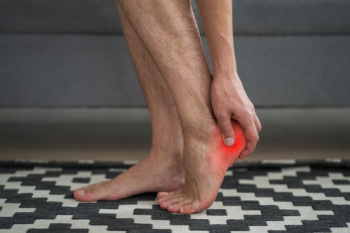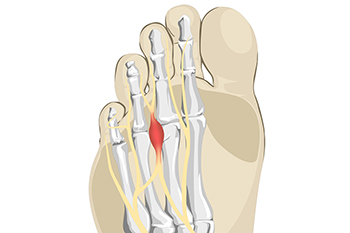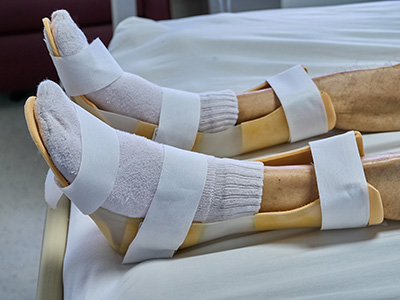Connect With Us
Blog
Items filtered by date: November 2024
Ankle Sprains and Anatomy

An ankle sprain occurs when the ligaments surrounding the ankle joint are overstretched or torn, resulting in pain and swelling. The ankle is made up of three bones which are the tibia, fibula, and talus, and held together by ligaments that provide stability. The most common ligaments involved in an ankle sprain are the anterior talofibular ligament and the calcaneofibular ligament. These ligaments help stabilize the ankle during movement. An ankle sprain typically happens when the foot twists or rolls in an unnatural direction, often during activities like running, jumping, or sports. Causes can include walking or running on uneven surfaces, sudden changes in direction, or wearing improper footwear. Symptoms include pain, swelling, bruising, and difficulty moving the foot or bearing weight. If you have sprained your ankle, it is suggested that you promptly schedule an appointment with a podiatrist who can provide an accurate diagnosis and effective treatment.
Although ankle sprains are common, they aren’t always minor injuries. If you need your ankle injury looked at, contact James Torhorst, DPM from Torhorst Foot and Ankle. Our doctor can provide the care you need to keep you pain-free and on your feet.
How Does an Ankle Sprain Occur?
Ankle sprains are the result of a tear in the ligaments within the ankle. These injuries may happen when you make a rapid shifting movement while your foot is planted. A less common way to sprain your ankle is when your ankle rolls inward while your foot turns outward.
What Are the Symptoms?
- Pain at the sight of the tear
- Bruising/Swelling
- Ankle area is tender to touch
- In severe cases, may hear/feel something tear
- Skin discoloration
Preventing a Sprain
- Wearing appropriate shoes for the occasion
- Stretching before exercises and sports
- Knowing your limits
Treatment of a Sprain
In many cases, the RICE method (Rest, Ice, Compression, and Elevate) is used to treat ankle sprains. However, you should see a podiatrist to see which treatment option would work best with your injury. In severe cases, surgery may be required.
It is important to ask your doctor about rehab options after you receive treatment for your injury. Stretching, strength training, and balance exercises may help the ankle heal while also preventing further injury.
If you have any questions, please feel free to contact our offices located in Waupaca and Stevens Point, WI . We offer the newest diagnostic and treatment technologies for all your foot care needs.
Heel Pain Can Be Treated!
Causes of Heel Pain While Walking

Heel pain while walking is a common issue that can stem from various causes. One of the most prevalent reasons is plantar fasciitis, an inflammation of the tissue that runs along the bottom of the foot. Overuse from excessive walking or running can also contribute to heel pain, particularly in individuals who do high-impact activities. Other factors include wearing improper footwear, which may lack support or cushioning, and conditions like Achilles tendinitis or heel spurs. To find relief, it is important to rest and reduce activity levels, allowing the heel to heal. Stretching exercises for the calves and plantar fascia can improve flexibility. Additionally, using supportive footwear or custom orthotics can provide the necessary support. Heel pain can cause difficulty in completing daily tasks, and it is suggested that a podiatrist is consulted who can determine what the cause is, and offer appropriate treatment solutions.
Many people suffer from bouts of heel pain. For more information, contact James Torhorst, DPM of Torhorst Foot and Ankle. Our doctor can provide the care you need to keep you pain-free and on your feet.
Causes of Heel Pain
Heel pain is often associated with plantar fasciitis. The plantar fascia is a band of tissues that extends along the bottom of the foot. A rip or tear in this ligament can cause inflammation of the tissue.
Achilles tendonitis is another cause of heel pain. Inflammation of the Achilles tendon will cause pain from fractures and muscle tearing. Lack of flexibility is also another symptom.
Heel spurs are another cause of pain. When the tissues of the plantar fascia undergo a great deal of stress, it can lead to ligament separation from the heel bone, causing heel spurs.
Why Might Heel Pain Occur?
- Wearing ill-fitting shoes
- Wearing non-supportive shoes
- Weight change
- Excessive running
Treatments
Heel pain should be treated as soon as possible for immediate results. Keeping your feet in a stress-free environment will help. If you suffer from Achilles tendonitis or plantar fasciitis, applying ice will reduce the swelling. Stretching before an exercise like running will help the muscles. Using all these tips will help make heel pain a condition of the past.
If you have any questions please contact our offices located in Waupaca and Stevens Point, WI . We offer the newest diagnostic and treatment technologies for all your foot and ankle needs.
Facts About Morton’s Neuroma

Morton's neuroma is a painful condition that occurs when a nerve in the foot becomes compressed or irritated, typically between the third and fourth toes. This condition often results in a sharp, burning pain in the ball of the foot, which may radiate into the toes. Patients commonly describe a sensation of having a pebble in their shoe, along with tingling or numbness in the affected toes. Diagnosing Morton's neuroma involves a thorough physical examination by a podiatrist, who may assess foot structure and check for tenderness in the affected area. Imaging tests, such as ultrasound or MRI scans, may be used to confirm the diagnosis and rule out other conditions. If you are experiencing symptoms of Morton’s neuroma, it is suggested that you consult a podiatrist who can accurately diagnose and treat this condition.
Morton’s neuroma is a very uncomfortable condition to live with. If you think you have Morton’s neuroma, contact James Torhorst, DPM of Torhorst Foot and Ankle. Our doctor will attend to all of your foot care needs and answer any of your related questions.
Morton’s Neuroma
Morton's neuroma is a painful foot condition that commonly affects the areas between the second and third or third and fourth toe, although other areas of the foot are also susceptible. Morton’s neuroma is caused by an inflamed nerve in the foot that is being squeezed and aggravated by surrounding bones.
What Increases the Chances of Having Morton’s Neuroma?
- Ill-fitting high heels or shoes that add pressure to the toe or foot
- Jogging, running or any sport that involves constant impact to the foot
- Flat feet, bunions, and any other foot deformities
Morton’s neuroma is a very treatable condition. Orthotics and shoe inserts can often be used to alleviate the pain on the forefront of the feet. In more severe cases, corticosteroids can also be prescribed. In order to figure out the best treatment for your neuroma, it’s recommended to seek the care of a podiatrist who can diagnose your condition and provide different treatment options.
If you have any questions, please feel free to contact our offices located in Waupaca and Stevens Point, WI . We offer the newest diagnostic and treatment technologies for all your foot care needs.
Night Splints and Foot Pain

Night splints are commonly used to treat foot conditions like plantar fasciitis and flat feet. These devices hold the foot in a dorsiflexed position while you sleep, which helps stretch the plantar fascia and Achilles tendon. This stretching reduces pain and inflammation by gently lengthening these tissues, promoting healing. Different types of night splints are available, including dorsiflexion splints that flex the foot upward, static splints that hold the foot in a neutral position, and posterior splints that provide support to both the foot and calf muscles. While some people may find night splints uncomfortable at first, many patients experience significant relief with regular use. Night splints are a non-invasive option and can be a valuable part of a treatment plan for foot pain. A podiatrist can help determine which type of night splint is best for your specific condition and ensure that it fits properly. If you have foot pain, it is suggested that you schedule an appointment with a podiatrist to see if night splints are right for you.
If you are having discomfort in your feet and would like to try orthotics, contact James Torhorst, DPM from Torhorst Foot and Ankle. Our doctor can provide the care you need to keep you pain-free and on your feet.
What Are Orthotics?
Orthotics are inserts you can place into your shoes to help with a variety of foot problems such as flat feet or foot pain. Orthotics provide relief and comfort for minor foot and heel pain but can’t correct serious biomechanical problems in your feet.
Over-the-Counter Inserts
Orthotics come in a wide variety of over-the-counter inserts that are used to treat foot pain, heel pain, and minor problems. For example, arch supports can be inserted into your shoes to help correct overarched or flat feet, while gel insoles are often used because they provide comfort and relief from foot and heel pain by alleviating pressure.
Prescription Orthotics
If over-the-counter inserts don’t work for you or if you have a more severe foot concern, it is possible to have your podiatrist prescribe custom orthotics. These high-quality inserts are designed to treat problems such as abnormal motion, plantar fasciitis, and severe forms of heel pain. They can even be used to help patients suffering from diabetes by treating foot ulcers and painful calluses and are usually molded to your feet individually, which allows them to provide full support and comfort.
If you are experiencing minor to severe foot or heel pain, it’s recommended to speak with your podiatrist about the possibilities of using orthotics. A podiatrist can determine which type of orthotic is right for you and allow you to take the first steps towards being pain-free.
If you have any questions please contact our offices located in Waupaca and Stevens Point, WI . We offer the newest diagnostic and treatment technologies for all your foot and ankle needs.

